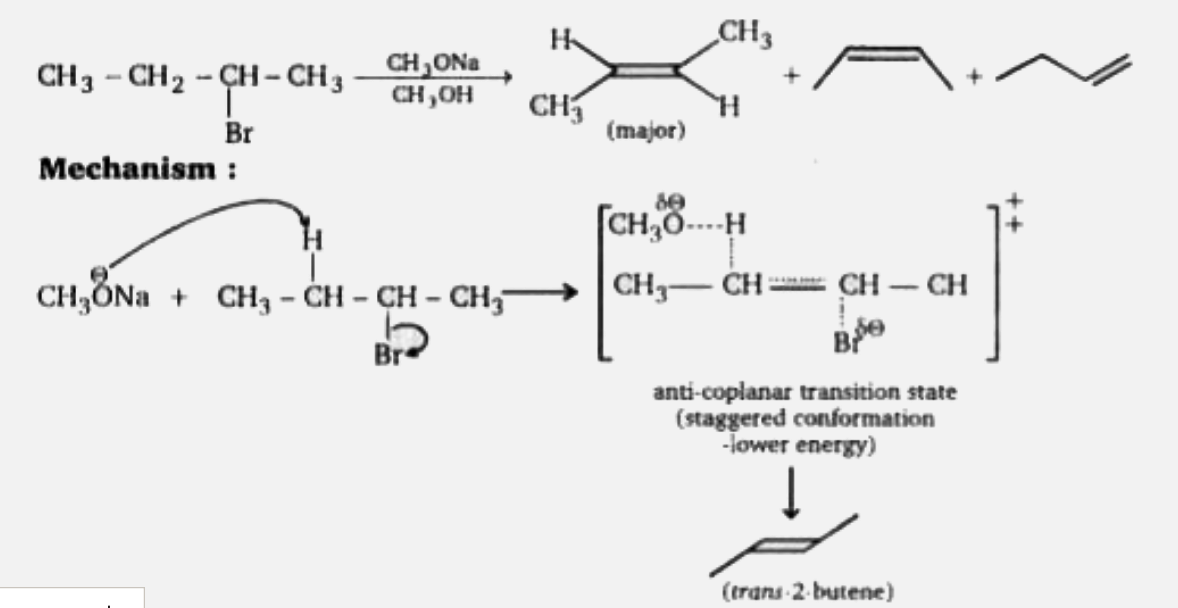Among the given halides, which one will give same product in both SN1 andSN2 reactions.
 Solution in Kannada
Solution in Kannada
(III) only
(I) & (II)
(III) & (IV)
(I), (III) & (IV)
The correct Answer is:D
SN2 and SN1 same if C⊕ not rearrange.
Topper's Solved these Questions
- ALKYL HALIDES (SUBSTITUTION REACTIONS)BOOK - MS CHOUHANCHAPTER - ALKYL HALIDES (SUBSTITUTION REACTIONS)EXERCISE - LEVEL-2
41 Videos
- ALKYL HALIDES (ELIMINATION REACTION) BOOK - MS CHOUHANCHAPTER - ALKYL HALIDES (ELIMINATION REACTION) EXERCISE - LEVEL-2
25 Videos
- AMINESBOOK - MS CHOUHANCHAPTER - AMINESEXERCISE - Level-2
1 Videos
Similar Questions
Statement - 1 : Nucleophilicity order in polar-protic solvent is I−<Br−<Cl−<F−
Statement-2 : Due to bigger size of I it is less solvated in polar-protic solvent.
View SolutionComprehension
E2 raction → Elimination bimolecular
In the general mechanism of the E2 reaction a strong base abstract a proton on a carbon atom adjacent to the one of the leaving group. As the abstracts a proton , a double bond forms and the leaving group leaves.

Identify the rate of reaction of given compounds in E2 reaction:

View SolutionFive amine syntheses are outlined below. In each reaction box enter a single letter designating the best reagent and conditions selected from the list at the bottom of the page.


View SolutionWhich of th efollowing alcohols are excepted to react with hydrogen halides by both S_(N)1 and S_(N)2 mechanisms ?
View SolutionIdentify number of substrate those can give S_(N^(1))" and "S_(N^(2)) reaction both .
View SolutionSN1andSN2 products are same with (excluding stereoisomer):
View SolutionAmong various alkyl halide which one is the most reaction towards SN1 reaction.
View SolutionVinyl halides are inert towards both SN1andSN2 reactions. Assign reason.
View SolutionThe correct decreasing order of reactivity for a given (R) group in both SN1 and SN2 reaction mechanism is :
View Solution2^(@) alkyl halides follow S_(N)1 and S_(N)2 both depending upon
View Solutionऐल्किल हैलाइड्स न्यूक्लियोफिलिक प्रतिस्थापन अभिक्रिया क्यों देते है ? उनके द्वारा प्रदर्शित SN1 व SN2 अभिक्रियाओं की क्रियाविधि का वर्णन कीजिए ।
View SolutionThe polarity of the carbon-halogen bond is responsible for the nucleophilic substitution reactions of alkyl halides which mostly occur by S_(N)1 and S_(N)2 mechanisms. The rates of S_(N)2 reactions among other things are governed by steric factors while than of S_(N)1 reactions are governed by the stability of intermediate carbocations. chirality has a profound role in undersetanding the mechanism of S_(N)1 and S_(N)2 reactions. whereas S_(N)2 reactions of chiral alkyl halides are accompanied by inversion of configuration, S_(N)1 reactions are characterised by racemisation. Q. Which of the following is an example of S_(N)2 reaction?
View SolutionThe polarity of the carbon-halogen bond is responsible for the nucleophilic substitution reactions of alkyl halides which mostly occur by S_(N)1 and S_(N)2 mechanisms. The rates of S_(N)2 reactions among other things are governed by steric factors while than of S_(N)1 reactions are governed by the stability of intermediate carbocations. chirality has a profound role in undersetanding the mechanism of S_(N)1 and S_(N)2 reactions. whereas S_(N)2 reactions of chiral alkyl halides are accompanied by inversion of configuration, S_(N)1 reactions are characterised by racemisation. Q. S_(N)1 reaction of optically active alkyl halides leads to
View SolutionAs SN2 reaction at an asymmetric carbon of a compound always gives:
View SolutionIn the solvolysis of 3-methyl-3-bromohexane, which of the following statements is not correct?
View SolutionMention the one-step reactions among S_(N)1,S_(N)2,EI and E2 .
View Solution
